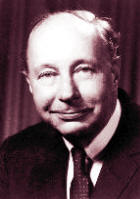Herbert H. Uhlig(1907-1993)
 Herbert Uhlig began his career at MIT in 1936 where, with the exception of the
interruption caused by World War II, he remained until his retirement nearly 40
years later. He brought the MIT Corrosion Laboratory to a level of international
prominence where it remains to this day as a major center of excellence. (reference
72)
He helped to establish the Corrosion Division of the Electrochemical
Society in 1942 and served as President of the Society in 1955-1956. His
characteristics as an uncompromising innovator and meticulous scientist
who insisted on reliable data and on achieving results led to the success
of his many endeavors as educator and mentor, including the Corrosion Handbook,
published in 1948, that he conceived, organized, and edited.
Herbert Uhlig began his career at MIT in 1936 where, with the exception of the
interruption caused by World War II, he remained until his retirement nearly 40
years later. He brought the MIT Corrosion Laboratory to a level of international
prominence where it remains to this day as a major center of excellence. (reference
72)
He helped to establish the Corrosion Division of the Electrochemical
Society in 1942 and served as President of the Society in 1955-1956. His
characteristics as an uncompromising innovator and meticulous scientist
who insisted on reliable data and on achieving results led to the success
of his many endeavors as educator and mentor, including the Corrosion Handbook,
published in 1948, that he conceived, organized, and edited.
The Corrosion Handbook was intended, as Professor Uhlig recorded in the Preface to the 1948 edition, to serve as "...a convenient reference volume covering the entire field of corrosion, to bring together, in effect, much of the information scattered broadly throughout the scientific and engineering literature."
Its success was equally heroic: the Corrosion Handbook has served generation after generation of corrosion engineers and today, more than half a century since its first printing, the volume remains a trusted resource in personal libraries of those in the world's engineering community. Realizing the importance of this book, Dr. Winston Revie, himself one of Prof. Uhlig's students, has edited the second edition to be published during the year 2000.
Friends and colleagues knew Professor Uhlig to be an enthusiastic outdoorsman He thoroughly enjoyed mountain climbing, hiking, swimming, canoeing, skiing, skating and many other outdoor activities. Professor and Mrs. Uhlig were members of the Appalachian Mountain club for many years. Mrs. Uhlig continues to live in their retirement home in Hancock, New Hampshire. She visits the Uhlig Corrosion Laboratory occasionally.
While the introduction of new technologies has dramatically changed virtually every aspect of life on Earth in the fifty years since the appearance of the Corrosion Handbook, what remains a persistent reality in the engineering enterprise is that engineering systems are built of materials. Whether an airframe, integrated circuit, bridge, prosthetic device or, perhaps as we shall see in the not too distant future, implantable drug delivery systems - the chemical stability of the materials of construction of such systems continues to be a key element in determining their useful life.

Connect with us
Contact us today